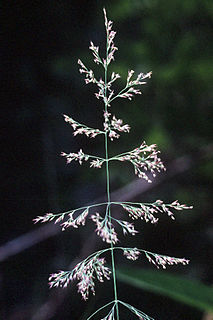
Calamagrostis is a genus in the grass family Poaceae, with about 260 species that occur mainly in temperate regions of the globe. Towards equatorial latitudes, species of Calamagrostis generally occur at higher elevations. These tufted perennials usually have hairless narrow leaves. The ligules are usually blunt. The inflorescence forms a panicle. Some may be reed-like.

Alisma is a genus of flowering plants in the family Alismataceae, members of which are commonly known as water-plantains. The genus consists of aquatic plants with leaves either floating or submerged, found in a variety of still water habitats around the world. The flowers are hermaphrodite, and are arranged in panicles, racemes, or umbels. Alisma flowers have six stamens, numerous free carpels in a single whorl, each with 1 ovule, and subventral styles. The fruit is an achene with a short beak.

Orobanche is a genus of over 200 species of parasitic herbaceous plants in the family Orobanchaceae, mostly native to the temperate Northern Hemisphere. Some species formerly included in this genus are now referred to the genus Conopholis. The broomrape plant is small, from 10–60 cm tall depending on species. It is best recognized by its yellow- to straw-coloured stems completely lacking chlorophyll, bearing yellow, white, or blue snapdragon-like flowers. The flower shoots are scaly, with a dense terminal spike of between ten and twenty flowers in most species, although single in O. uniflora. The leaves are merely triangular scales. The seeds are minute, tan-to-brown, and blacken with age. These plants generally flower from late winter to late spring. When they are not flowering, no part of the plants is visible above the surface of the soil.
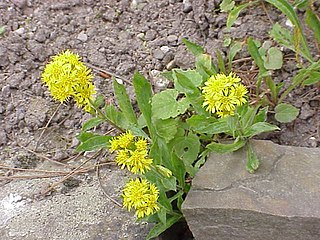
Solidago virgaurea is an herbaceous perennial plant of the family Asteraceae. It is widespread across most of Europe as well as North Africa and northern, central, and southwestern Asia. It is grown as a garden flower with many different cultivars. It flowers profusely in late summer.

Xerochrysum is a genus of flowering plants native to Australia. It was defined by Russian botanist Nikolai Tzvelev in 1990, preceding Bracteantha which was described the following year. A 2002 molecular study of the tribe Gnaphalieae has indicated the genus is probably polyphyletic, with X. bracteatum and X. viscosum quite removed from each other.

Achnatherum is a genus of plants which includes several species of needlegrass. Several needlegrass species have been switched between Achnatherum and genus Stipa; taxonomy between the two closely related genera is still uncertain.
Solanum luteoalbum is a species of plant in the family Solanaceae.
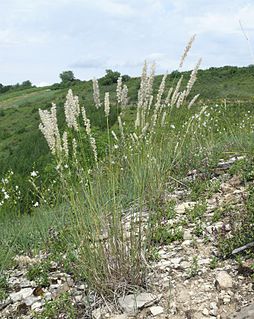
Melica is a genus of perennial grasses known generally as melic or melic grass. They are found in most temperate regions of the world.
Knorringia is a genus of plants in the family Polygonaceae. It is native to Central Asia and Siberia.

Rostraria is a genus of plants in the grass family, native primarily to Eurasia and North Africa with one species native to South America. Hairgrass is a common name.

Helichrysum luteoalbum is commonly known as Jersey cudweed or cat's paw.

Pseudognaphalium is a genus of flowering plants in the sunflower family.
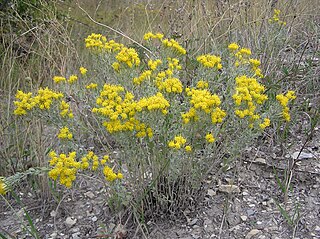
Galatella is a genus of flowering plants in the daisy family, native to Europe, Asia, and northern Africa.
Australopyrum is a genus of plants in the grass family, native to Australia, New Zealand, and New Guinea.
Pseudohandelia is a genus of flowering plants in the chamomile tribe within the daisy family.
Arctanthemum is a genus of flowering plants in the daisy family.
Hyalopoa is a genus of Asian plants in the grass family.

Leymus akmolinensis is a species of grass endemic to Russia and Kazakhstan.

Stipa zalesskii is a grass found in Europe and Asia. It is an important grass in Eurasian steppe. Its culms are 30–75 cm long and the leaf-blades 20–35 cm long by 0.6–1 mm wide.
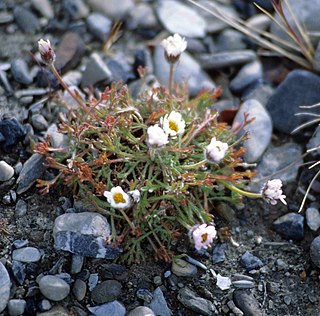
Arctanthemum integrifolium, the entire-leaved daisy, is a subarctic species of plant in the sunflower family. It grows in Alaska, northern Canada, Peary Land in northern Greenland, and the East Chukotka region of eastern Russia.














